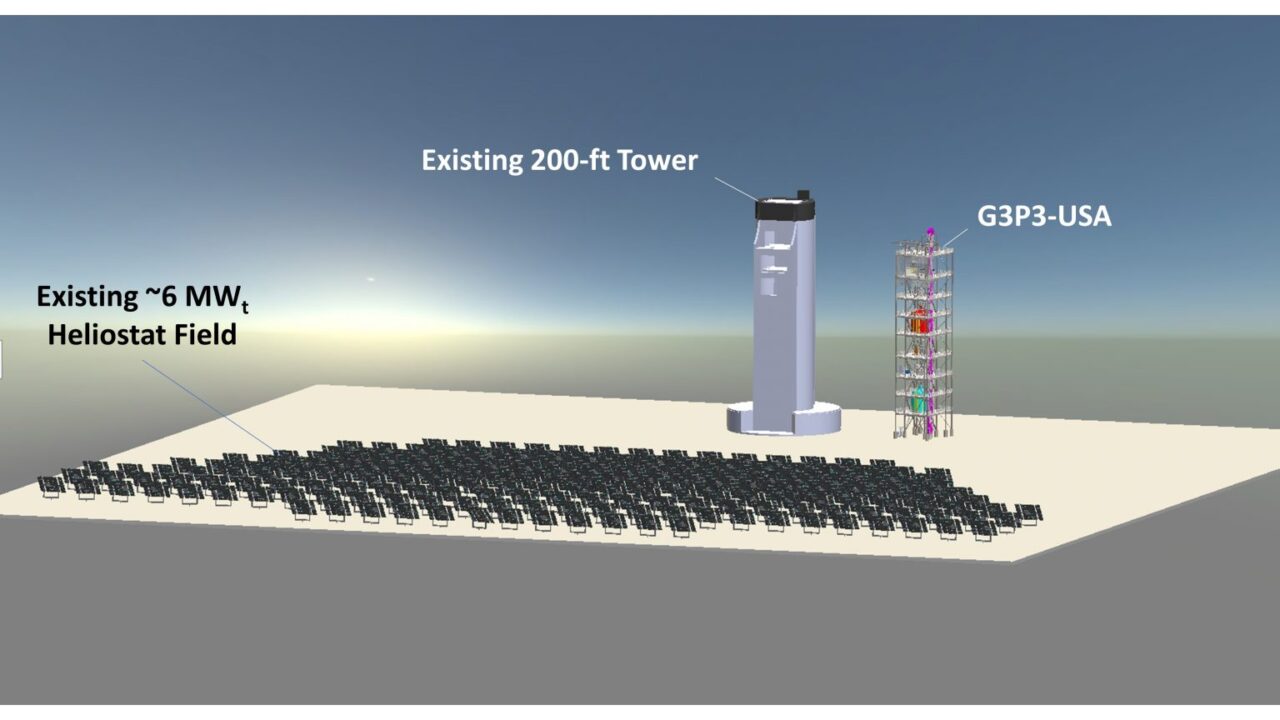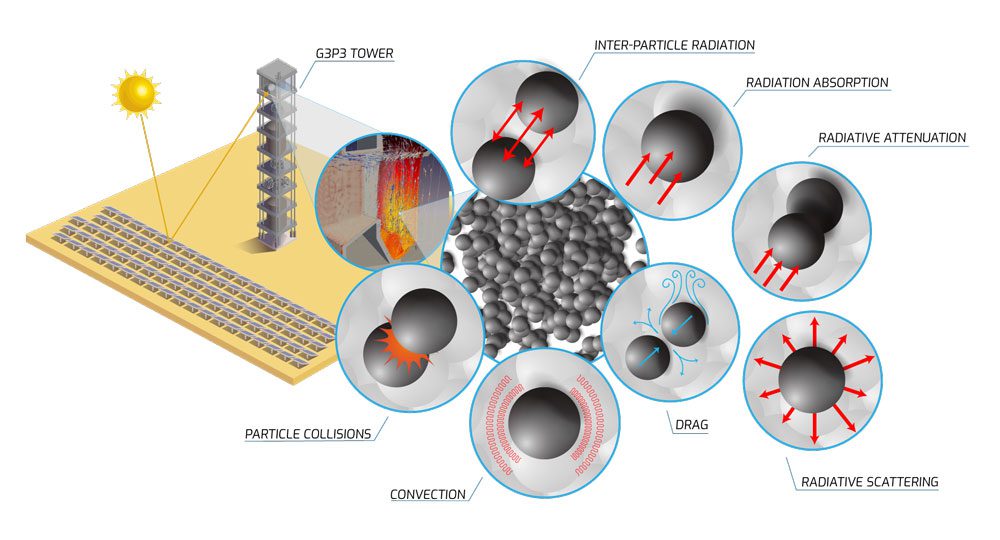DOE Breaks Ground on Next-Generation Concentrating Solar Power Pilot

The Department of Energy (DOE) has broken ground on the Generation 3 Particle Pilot Plant (G3P3), a novel concentrating solar power (CSP) facility at Sandia National Laboratory that will use sand-like ceramic particles instead of molten salt to produce and store high-temperature energy.
When completed in 2024, the multi-megawatt" solar thermal pilot project will utilize an existing heliostat field at Sandia's National Solar Thermal Test Facility (NSTTF) in Albuquerque, New Mexico, to concentrate sunlight on a gravity-driven particle-based receiver and heat the receiver's ceramic-based particles to more than 700C. Along with potentially enabling at least six hours of particle-based energy storage, the system will notably demonstrate heating of a working fluid-supercritical carbon dioxide (sCO2)-to 700C or more, using a highly efficient sCO2 Brayton cycle to generate electricity.
 The G3P3 concentrating solar-thermal pilot facility at Sandia National Laboratories in New Mexico will use sand-like ceramic particles instead of molten salt. The particles, which can withstand temperatures greater than 800C, can be used to transfer and store heat or power a supercritical carbon dioxide (sCO2) turbine. If successful, this type of solar power plant could provide 100 MW of power continuously, around the clock, at low cost," the DOE said. Source: DOE
The G3P3 concentrating solar-thermal pilot facility at Sandia National Laboratories in New Mexico will use sand-like ceramic particles instead of molten salt. The particles, which can withstand temperatures greater than 800C, can be used to transfer and store heat or power a supercritical carbon dioxide (sCO2) turbine. If successful, this type of solar power plant could provide 100 MW of power continuously, around the clock, at low cost," the DOE said. Source: DOEIf successful, this type of solar power plant could provide 100 MW of power continuously, around the clock, at low cost" and showcase storage technology that could provide one gigawatt of storage for one hour at a single plant," the DOE said on Feb. 17. The pilot could also pivotally prove that a particle-based CSP plant can achieve the DOE's goal of making electricity-plus-storage from CSP at $0.05/kWh.
That would be a game-changer," Alejandro Moreno, acting assistant secretary for the DOE's Office of Energy Efficiency and Renewable Energy (EERE), said on Friday. This pilot facility will demonstrate how CSP systems can meet the challenges of providing long-duration energy storage while reducing costs and complexity for solar thermal technology. At the same time, it also provides a pathway to commercialization for industrial process heat," he said.
A CSP Pilot Five Years in the MakingThe G3P3 pilot's recent groundbreaking culminates a five-year, $100 million federal research effort to develop a next-generation" of CSP technologies that will be efficient and cost-competitive. The pilot is part of the DOE's 2017-initiated Generation 3 CSP funding project, which evolved from the agency's 2011-launched SunShot Initiative. Overseen by the DOE's Solar Energy Technologies Office (SETO), the Generation 3 program evaluated three technology pathways-liquid, solid particle, or gaseous/supercritical fluid- that could enable high-temperature (and high-efficiency) CSP plants.
A key Generation 3 program objective has been to demonstrate an integrated system-not just on a component level, as was pursued under SunShot-to prove out new technologies and reduce risk, as well as to demonstrate CSP's reliability, cost-competitiveness, and flexibility.
In May 2018, the DOE awarded $62 million under a competitive solicitation to 11 projects in two areas. About $9.4 million went to Sandia for the first two phases of G3P3 under the Integrated Gen3 Systems" topic area. The award considered Sandia's successful development and demonstration in the early 2010s of a 1-MWth high-temperature directly irradiated falling particle receiver system prototype. The national laboratory said the prototype installed at its NSTTF achieved particle temperatures of more than 800C with continuous recirculation.
Sandia immediately kicked off Phase 1, which spanned 18 months over 2019 and 2020, working on risk mitigation related to receiver, storage, heat exchanger, particle, and particle lift technologies. Under Phase 2, which the national laboratory wrapped up over six months in 2020, it delivered an integrated system design.
In March 2021, as the White House announced a new ambitious target to cut the cost of solar energy by 60% by 2030, the DOE awarded Sandia $25 million (with Sandia footing a $5 million awardee cost share) to proceed with Phase 3: Building the G3P3 pilot. The DOE said it made the selection after evaluating whether the concept for the new CSP plant had been de-risked in the first two phases of the funding program and whether the plant could meet the solar office's 2030 goals."
What Is Particle-Based CSP?Sandia's concept, notably, uses aluminum oxide-based particles (ceramic bauxite) with a diameter of about 300 micrometers in its falling particle receiver (FPR). In the FRP, the particles are dropped within a cavity as a curtain, past a beam of concentrated sunlight that heats them," the lab said.
 Sandia evaluated technology risks under the first two phases of the G3P3 project. The third phase entails building and demonstrating the pilot. This graphic shows the G3P3 falling particle receiver's simulated thermal response under nominal conditions. Source: Sandia National Laboratory
Sandia evaluated technology risks under the first two phases of the G3P3 project. The third phase entails building and demonstrating the pilot. This graphic shows the G3P3 falling particle receiver's simulated thermal response under nominal conditions. Source: Sandia National LaboratoryThe heated particles are then stored in an insulated bin before passing through a particle-to-working-fluid heat exchanger. Sandia's heat exchanger's working fluid, notably, will simulate a high-efficiency Brayton cycle using sCO2 with an exit temperature of 720C. The cooled particles will then be collected and moved back to the top of the receiver via a bucket elevator or skip hoist, and then dropped in the FPR and heated again.
The biggest advantage of particles is that they enable the FPR to reach very high temperatures (>800C) where traditional CSP heat transfer mediums do not. This allows use of the efficient sCO2 cycle, making the electricity much cheaper," Sandia said.
The DOE noted that compared to its Generation 3 program's liquid and gaseous heat-transfer pathways, particle-based CSP systems require fewer components and are less complex to operate. Additionally, particle-based systems need relatively few high-cost materials to collect and transport thermal energy. These factors could increase plant availability and reliability and enable simpler plant construction and commissioning."
Meanwhile, unlike the two other pathways, ceramic, sand-like particles could provide crucial flexibility needed by future energy systems, the DOE noted. Because particles can withstand temperatures greater than 800C, along with power production, they could energize solar-thermal heat applications, including industrial process heat, thermochemical energy storage, and solar fuel production, the agency said.
The pilot demonstration is expected to shed more light on questions about the integration and scaling of the technology. Sandia, however, has suggested that if successful, the technology will be scaled up to plant sizes as large as 100 MWe with the ability to store energy for times when sunlight is not readily available."
For now, Sandia is working to accelerate deployment and commercialization of the G3P3 concept. It has teamed with international researchers in Saudi Arabia and Australia to test variants of key systems and components.
So far, a second G3P3 pilot in Saudi Arabia sponsored by the Saudi Electricity Company (SEC) is also currently under development. That effort builds on the successful testing of a 300-kWt falling-particle-based CSP system developed by King Saud University, with support from the Kingdom of Saudi Arabia (KSA). A clear path towards commercialization will be identified, if not demonstrated, through our international development efforts," the lab noted in recent project documents. We feel that the proposed G3P3-USA and G3P3-KSA systems will create a marketable pathway for next-generation high-temperature CSP systems."
The end goal of the G3P3 project is to complete more than 2,000 hours of combined testing at the U.S. G3P3 and Saudi G3P3 integrated particle-receiver systems that meet desired SunShot metrics, Sandia noted. That includes demonstrating a thermal duty of 1-MWth or more for the receivers and heat exchangers. While the U.S. project will heat a sCO2 working fluid to more than 700C, the Saudi one will heat air to more than 700C, it said.
-Sonal Patelis a POWER senior associate editor (@sonalcpatel,@POWERmagazine).
The post DOE Breaks Ground on Next-Generation Concentrating Solar Power Pilot appeared first on POWER Magazine.